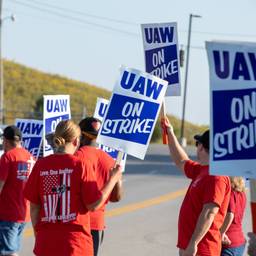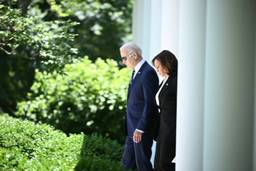Here's What Striking Autoworkers Are Fighting For
The Big 3 automakers have made record profits in recent years. Now, union workers are calling for big raises, an end to tiers, a shorter work week and a just transition.
Jeff Schuhrke

This story has been updated.
After decades of accepting concessions demanded by the Big Three automakers, the United Auto Workers (UAW) is now making bold demands of its own in one of the most spirited contract campaigns in the union’s recent history. At midnight on September 14, when the union’s contracts expired with Ford, GM and Stellantis without an agreement, workers at all three automakers went on strike at targeted locations.
The Big Three have made a combined nearly quarter trillion dollars in profits in North America over the past decade — including $21 billion in the first six months of 2023 alone. The companies’ shareholders and executives have been richly rewarded through stock buybacks and exorbitant salaries.
Meanwhile, the workers who actually make the cars have seen their real wages plummet by 30% over the past 20 years. In what was once a middle-class career, some autoworkers now make as little as $15.78 per hour, often working overtime to earn enough to support their families.
The union’s contract proposals, which UAW President Shawn Fain describes as “audacious and ambitious,” aim to not only counter the effects of recent inflation, but also to undo the consequences of years of concessionary bargaining by the UAW’s corrupt former leadership clique, whom Fain and a slate of rank-and-file-backed reformers replaced this March in the union’s first-ever election where top officers were directly chosen by the membership.
“You cannot make $21 billion in profits in half a year and expect members to take a mediocre contract,” said Fain. “Our campaign slogan is simple: record profits mean record contracts.”
The UAW’s proposals include:
Ending tiers. Before a major contract concession in 2007, newly hired auto workers could reach the maximum wage rate within three years and have guaranteed pensions and retiree healthcare. But “second-tier” workers — those hired since 2007 — must wait at least eight years before reaching top wage levels and get no pensions or post-retirement healthcare. The Big Three have also increasingly hired workers as low-paid temps, often extending the length of their supposedly “temporary” status before they can become permanent employees. The UAW wants to equalize pay and benefits so that all autoworkers, now and in the future, have pensions and retiree healthcare, and can reach maximum pay and permanent status within 90 days of being hired.
Double-digit raises. The multimillionaire CEOs of GM, Ford and Stellantis have gotten an average raise of 40% over the past four years, so the union is seeking similarly large raises of around 46% for autoworkers over the course of the four-year contract. The UAW is relatedly calling for significant increases to the pension benefit paid to retirees.
Restoring cost-of-living adjustments (COLAs), which tie wages to inflation. Once a signature feature of autoworker contracts, the UAW’s former leadership agreed to suspend COLAs in 2009 as GM and Chrysler faced bankruptcy amid the Great Recession.
Work-life balance. Because their real hourly wages have fallen so dramatically amid years of concessions, many autoworkers put in 60 to 80-hour weeks to make ends meet, leaving less time to spend with their families. In addition to calling for more paid time off, the UAW is making the eye-catching demand for a 32-hour workweek at 40 hours’ pay. “If Covid did anything, it made people reflect on what’s important in life, and it sure as hell isn’t living in a factory,” Fain said last month.
Job security. With automakers shutting down factories and moving production to wherever in the world they can exploit workers the most — a process that has gone on for over 40 years and continues—the UAW is demanding the right to strike over plant closures and is calling for the creation of a Working Family Protection Program, which would make the companies keep employees at shuttered factories on payroll doing community service work.
Enhanced profit sharing. With the Big Three’s shareholders reaping the benefits of record profits, the union is proposing that workers get $2 for every $1 million spent on stock buybacks and special dividends.
A just transition to electric vehicle (EV) manufacturing. Aided by federal subsidies, the Big Three are building EV battery plants as “joint ventures” with South Korean tech firms. But these new factories fall outside the collective bargaining agreements covering other UAW autoworkers, so wages and working conditions are far worse than at plants making gas-powered cars. As part of its fight to eliminate all tiers, the UAW wants to extend the same union standards to new EV plants. Since EV workers are not currently covered by the Big Three contracts, this is a public demand rather than a bargaining proposal. “The people who make cars shouldn’t have to choose between a green, sustainable job and one that pays good wages they’ve negotiated,” Sierra Club Executive Director Ben Jealous wrote last week in support of the UAW.
These proposals have energized the UAW’s rank and file, whose frustration at the retreats overseen by the union’s former leadership helped prompt them to elect Fain earlier this year.
“We vote on these contracts, but we also have been led to believe that this is all we can get, this is all we’re worth. And I believe that it’s time to change that mindset, that we are worth more,” explained Sara Schambers, a Ford worker in Livonia, Michigan.
A fourth-generation autoworker, it took Schambers 15 years to reach Ford’s maximum pay of $32 per hour, including six years as a “temp.” In contrast, it took her mother just three years to reach the company’s top wage rate.
“We need to stop getting left behind and be the working class again, instead of the working poor,” Schambers said.
Unlike previous negotiations at the Big Three, the new UAW leadership is keeping the rank and file well informed about developments at the bargaining table. Fain is hosting regular Facebook Live streams viewed by thousands of members, where he lays out the companies’ counteroffers — which so far have not come close to meeting the unions’ demands — and places them in what he calls the “proper filing cabinet”: a trash bin.
Additionally, the union ran a high-profile contract campaign this summer, with members and allies holding rallies and practice pickets from coast to coast. This kind of member engagement and public outreach did not happen during Big Three negotiations in the recent past, including in the run-up to the 2019 GM strike.
“I think for the UAW rank and file it is so refreshing to see this and to begin to identify with the UAW that they want to identify with,” said retiree Frank Hammer, a veteran UAW activist and former president of Local 909 in Warren, Michigan.
Hammer recently told Status Coup News that the union has experienced “a dramatic turnaround” in the six months since Fain was elected. “We are now talking about fighting back, fighting for what was lost and fighting in regards to what’s coming,” he said.
But not everyone is happy with the UAW’s more militant direction.
In recent weeks, media outlets have bombarded the public with warnings that an auto strike would send car prices soaring, wreak havoc on the supply chain and devastate the economy. Several of these news stories have uncritically highlighted a report produced by a consultancy firm that lists GM and Ford as business clients.
“You don’t hear the media wringing their hands over how Big Three profits are driving up the cost of cars,” Fain said last week. “You don’t see big splashy nightly news segments on how consumers will be impacted by companies choosing to spend billions on executive salaries and stock buybacks and special dividends.”
Fain himself has been demonized by many in the establishment media, with numerous news outlets referring to the UAW’s democratically elected president as a “union boss.” The Chicago Tribune’s editorial board called Fain “problematic” and “belligerent,” while CNBC anchor Jim Cramer said on the air last month that he finds the union leader “frightening.”
“He’s talking about capitalism and the nature of capitalism and how it really hurts workers,” Cramer said of Fain. “And then the notion that we’re fat cats, the shareholders are fat cats and have been overly rewarded…That’s class warfare. And it’s very shocking to hear class warfare.”
Despite this media onslaught, a recent Gallup poll found that a whopping 75% of Americans say they side with the autoworkers in their contract fight.
“Working people in this country know what’s really going on,” Fain said in a recent video. “We know what it’s like to live paycheck to paycheck while the companies we work for make out like bandits…We know the truth, and the truth is that the cost of a strike might be high, but the cost of doing nothing is much higher.”
Jeff Schuhrke is a labor historian and assistant professor at the Harry Van Arsdale Jr. School of Labor Studies, SUNY Empire State University. He is the author of Blue-Collar Empire: The Untold Story of US Labor’s Global Anticommunist Crusade.










